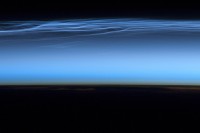This graphic shows how methane, a greenhouse gas, boosts the abundance of water at the top of Earth’s atmosphere. This water freezes around “meteor smoke” to form icy noctilucent clouds. (Graphic courtesy of Prof. James Russell of Hampton University)
Home This graphic shows how methane, a greenhouse gas, boosts the abundance of water at the top of Earth’s atmosphere. This water freezes around “meteor smoke” to form icy noctilucent clouds. (Graphic courtesy of Prof. James Russell of Hampton University) This graphic shows how methane, a greenhouse gas, boosts the abundance of water at the top of Earth's atmosphere. This water freezes around "meteor smoke" to form icy noctilucent clouds. (Graphic courtesy of Prof. James Russell of Hampton University)



